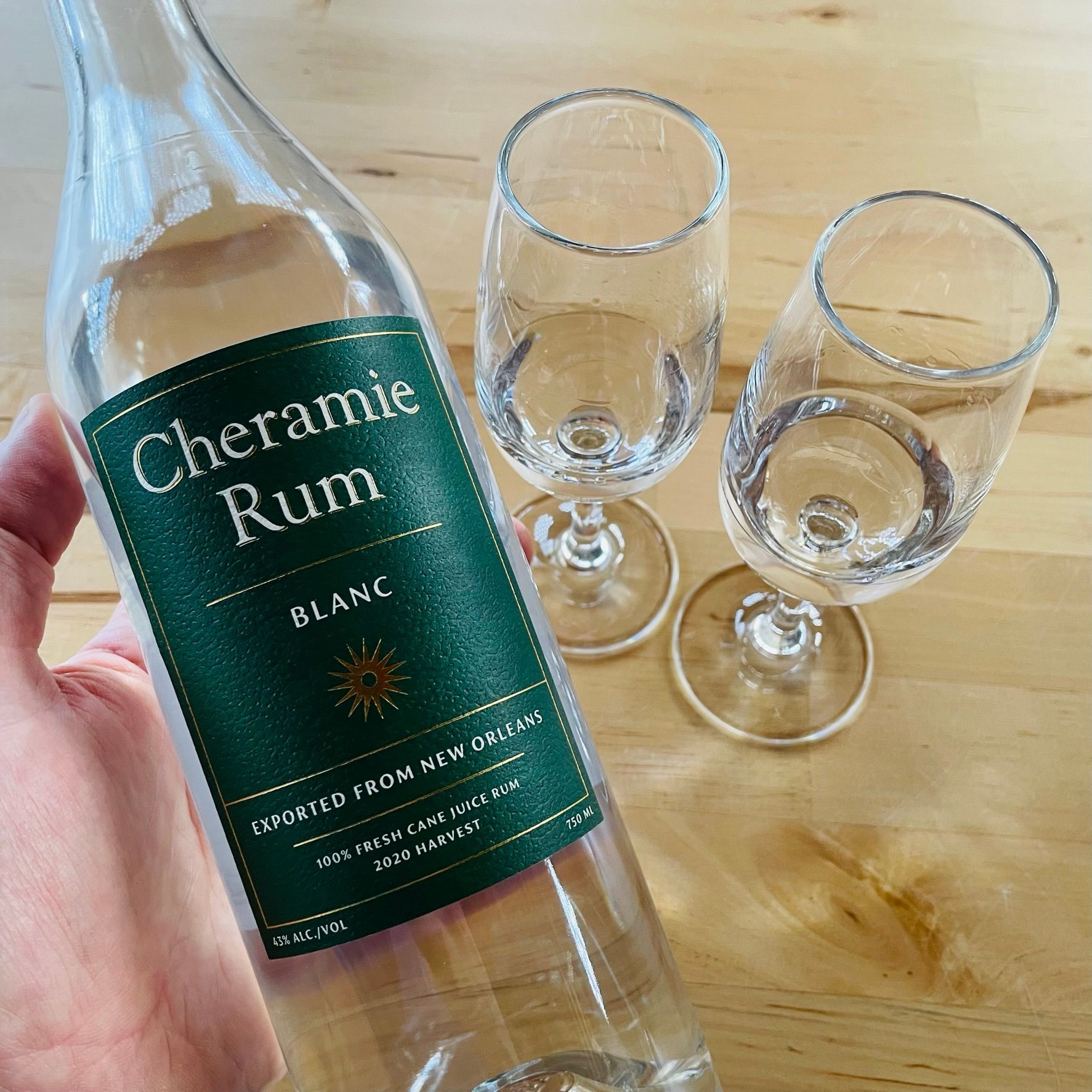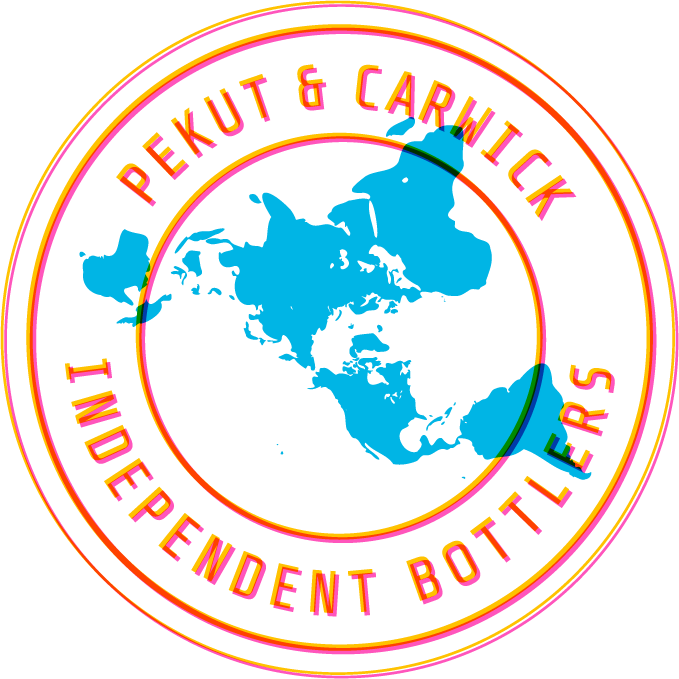Meet Cheramie Rum

Until recently, Louisiana’s largest distillery—Porchjam—specialized in grain-based vodka. But in 2018, they (literally) started tapping into the nearby annual cane harvest and distilling fermented fresh cane juice.
Soon after, Cheramie Rum was born.
While most of the juice from Louisiana’s sugarcane plants is processed into sugar, Cheramie manages to ferment a relatively small portion for distilling into funky, delicious, 100% Louisiana-grown and made rum. Harvest, crush, fermentation, and initial distillation (stripping) typically take place in a short window of time between October and January, with stills running nonstop over 12+ hour shifts to stabilize the highly perishable juice.
Just as last year’s cane crush was coming to a close, we had the good fortune to speak with American Cane Juice Rum pioneer Jason Zeno, also Director of Operations at Cheramie, and we got his enthusiastic take on this burgeoning new category in American rum.
True to the fruit
Zeno has been passionate about distilled spirits since he was sixteen years old, learning the tricks of the wine trade from a family vintner friend. His later career in the spirits industry took him from grappa to whiskey to bourbon—Pittsburgh, Oregon, Kentucky—but he considers making rum in Louisiana the culmination of his life’s work.
When he joined Porchjam Distillery in 2018, the company was busy producing a popular line of all-grain vodka and brainstorming a venture into rum, but when Zeno drove through the cane fields just an hour's drive outside the city, he knew his fate with rum was sealed.
While most rum distillers buy commodity molasses (a commodity sugar waste stream) to make their rum, cane juice is more elusive, harder to control, and according to Zeno, a deliciously challenging pain in the ass. Cane only grows in a few regions of the US and it’s highly perishable, carrying with it a heavy microbiological load. The minute the sugarcane is cut, every sugar-loving microbe living on the surface of the stalk (wild yeast, bacteria, pretty much everything loves sugar) gets to work on the newly unprotected natural sugars. After the sugarcane is pressed and juiced, the sweet liquid—Zeno calls it Mississippi mud water—must be rushed into a fermentation tank, or within hours the precious juice will ferment of its own accord, picking up undesirable flavor compounds and quickly spoiling. At Porchjam, the cane juice is hauled from the mill in 6,000 gallon truckloads to the distillery, where it is pumped into a fermentation tank. Yeast is pitched immediately and the wash is fermented to dryness (when all the sugars are consumed about 36 hours later), before heading to the stills.
It’s partly the connection between agriculture and spirits that Zeno wants to emphasize with Cheramie rum. “I love wine,” says Zeno, “it’s alive. It’s true to the fruit. I want to teach people that rum is made with an agricultural product, and can have a real terroir.”
“We’re between agricole, cachaça, and clairin,” says Zeno. “It’s a new category of cane juice spirit.”
While molasses tends to lose its cane juice character during sugar refining, fresh cane juice is alive and redolent of the field, region, and climate it comes from. “If I got cane from Florida,” says Zeno, “it would be a different product.” The rum he makes at Cheramie is deeply tied to the locality of the cane—about seven different cane varietals grown on three farms just a few hours away from the distillery. For connoisseurs seeking the ever elusive terroir of rum, it doesn’t get more (literally) down and dirty than Mississippi Mud Water and the funky spirit Zeno makes from it.
Age statements: mostly just smoke and mirrors
Zeno eschews the heavy oak and wood sugar profile of new American oak casks to age Cheramie’s rums, instead preferring used barrels that won’t dominate or obliterate the delicate, funky flavors of the cane juice. “New American oak is a bit of a sledgehammer,” says Zeno, who sees the rum he makes almost like an eaux-de-vie or fine brandy, “I want to stay true to the ‘fruit.” He’s currently experimenting with a solera-style aging system, and will continue to build on it each year as he and his colleagues lay down fresh rum.
But ask Zeno about his philosophy on age statements, and he won’t mince words.
“Age statements are fucking nonesense,” he says. “An age statement is only good depending on the oak the spirit went into, and was the rickhouse climate controlled, was it hot or humid? When you get into rum, the age statement doesn’t really give you enough information.”
Consumers love the idea of aged spirits, and distillers and spirit marketers happily apply age statements to everything they can get their hands on, in an attempt to woo customers with the promise of vintage oak, wood sugars, and a sophisticated tipple. But age alone does not a delicious spirit make. As Zeno fervently points out, there are many factors involved in the aging process. A barrel aged four years in the heat of Barbados will taste vastly different from one aged on a damp London dock. Zeno isn’t sure he’ll be aging any of his rums for more than four years. But time will tell.
American Rum
Porchjam is one of just a few distilleries in the US making cane juice rum, and Zeno appears to be the only distiller among them who is aiming for both scale and quality. This means he’s charting new territory in the world of American Rum, possibly even breaking open a new subcategory in global rum. But he’s very careful to point out that Porchjam isn’t making agricole rum, the name for Appellation d'Origine Contrôlée (AOC) protected rums of Martinique and Guadeloupe.
Designations and standards like the AOC tie a product to the specific region where it is produced, and create a set of quality and process standards by which all products in the category may be measured. “It’s going to take a while, securing an AOC-type designation for American cane juice rum, but I think Louisiana should be the rum spot the way Kentucky is for bourbon,” says Zeno. If American Cane Juice Rum was able to secure a federal standard of identity, it would put it on a footing with other regionally protected spirits like bourbon whiskey, and soon, American Single Malt Whiskey.
Creating a new American Rum category would provide a unique opportunity to bake ethical sourcing into the official standard of identity, and the necessarily shorter cane juice supply chain already provides a degree of transparency for consumers who want to know where the raw materials are coming from.
Rum For the People
Creating a consistent rum from a perishable and variable agricultural product is a challenge Zeno embraces, but unlike some cane juice distilling devotees, he isn’t in the business of creating small-batch, boutique rums. Zeno wants to make rum for everybody, i.e., both delicious and affordably priced, the kind of spirit you can sip on or shake up in a cocktail without buyer’s remorse. This is new territory for American Rum, one that aims to bring the hallmarks of artisanal craftsmanship in spirits to a wider audience, backed by years of experience in high volume quality spirits production and marketing.
Zeno and his team are eager, and likely, to put Louisiana rum on the map. We can’t wait to share our Cheramie Rum Blanc with you, and we will be rooting for Zeno and his colleagues as they forge a new path for American Cane Juice Rum.
We think Cheramie is a game changer for the rum industry, and if you read our last missive about Third Wave Rum, you’ll know that one key component of promoting this new spirits category is to get as many consumers behind it as possible. With enough consumer critical mass, we can send a signal to the industry that American Cane Juice Rum is here, and it's here to stay.
